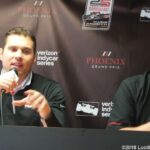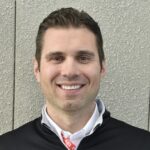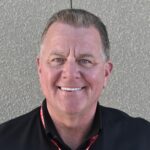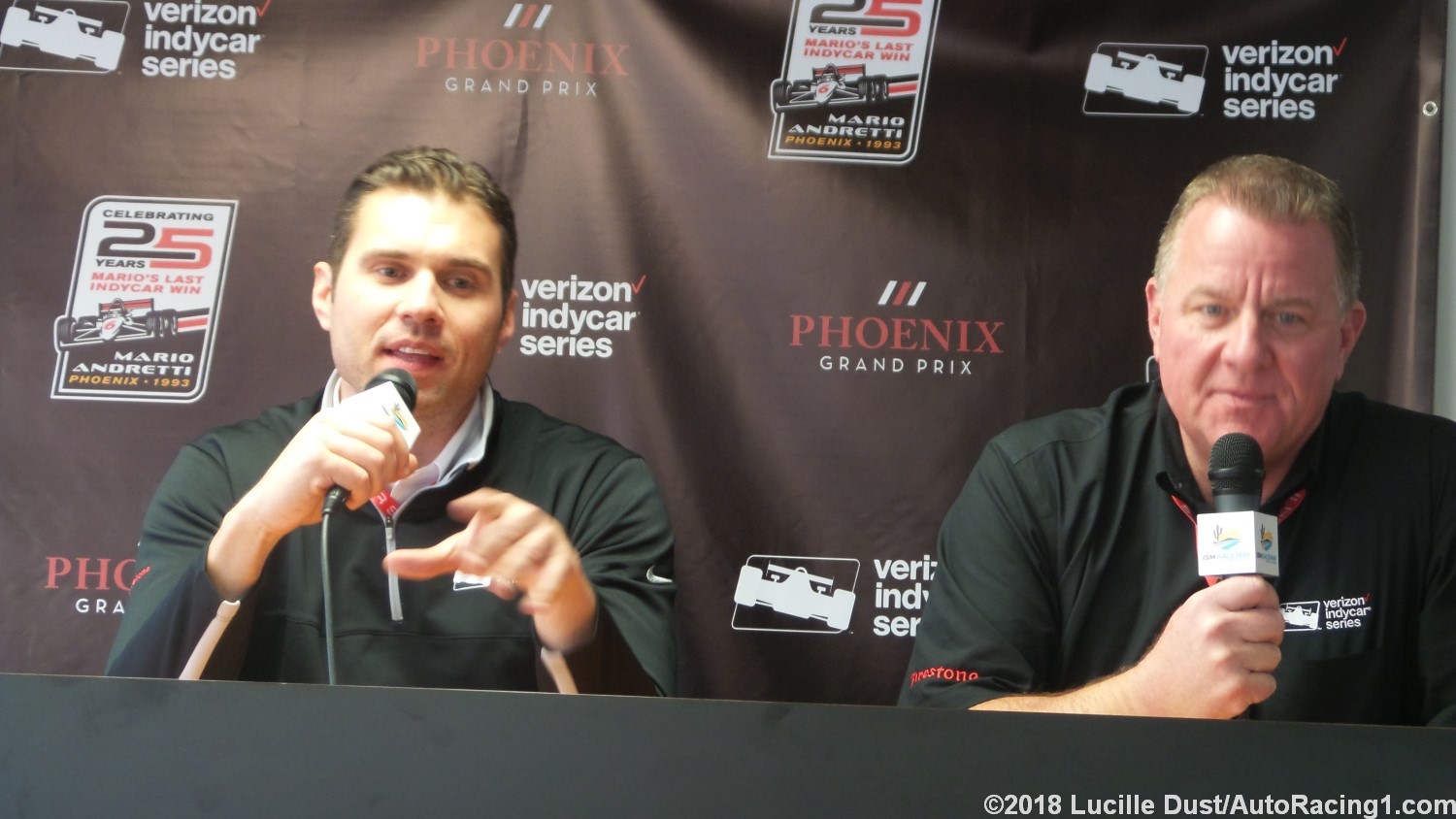Q&A with IndyCar’s Frye and Novak
 |
| Novak and Frye |
Jay Frye – President of Competition and Operations
Kyle Novak – New Race Director
Press Conference
THE MODERATOR: We have with us INDYCAR's president of competition and operations, Jay Frye, here to my immediate right, and Kyle Novak, the Verizon IndyCar Series' race director. Welcome, Kyle. It's kind of a new experience being in the INDYCAR paddock. He's a fan of boxing, comes to us most recently from the sports car world, so welcome. Good to have you.
KYLE NOVAK: Thanks. Good to be here.
THE MODERATOR: Jay, if you'll tell us a little bit about what was attractive to you about Kyle's résumé and why you brought him into this position.
JAY FRYE: Well, we looked far and wide and did a lot of research, did a lot of different things, and Kyle's name just continued to come up, so at some point we figured his name has come up enough, so this must be a really good kid. Kid, sorry. So we were really excited to have the opportunity to talk to Kyle. When we ran with the sports cars some, we got to know him some, so it was a really good thing that we were able to get this done. Really excited to have you on board. This could be really good — we expect really great things, really long-term type situation, so we're really excited to have him.
THE MODERATOR: Kyle, talk about the differences between the sports car world. Obviously today is a really good example of that; the cars, everywhere they went today they were in your line of sight on an oval compared to a road course. How was this different?
[adinserter name="GOOGLE AD"]KYLE NOVAK: More similarities really than differences. The one thing about running a race, running every session, is the core people and the core roles and the core responsibilities are largely the same. I think one of the common misconceptions about being a race director is you're up there by yourself with one radio, kind of running, pointing and being a dictator up there. It's really just as much about almost a mission control type scenario where you're managing the room, managing the information flow, just as much as you're managing the particular sporting aspects of the series.
The ovals will certainly be new to me. I've never called a race on an oval before. But we have such a great support and great operational structure here at INDYCAR, and just hundreds of years and thousands of races of experience that will really help me through that transition.
THE MODERATOR: You have a background with Indy car racing several years ago. Talk about your experience, where you ran and at that point in your year.
KYLE NOVAK: Yeah, my first really thrust really into the professional racing side was street course construction, street course design and construction during the Champ Car days, so had the opportunity to build the Cleveland event, Houston, Denver, and consulted on several more design aspects for many more, and that's really what gave me the first knowledge of the operational aspects of what it takes to put race control together and really the nuts and bolts of what it takes to put these courses together and get them up and running and up and running efficiently especially.
THE MODERATOR: Interesting, your career didn't actually start in racing, it started in football, and you were on — at least as a young person, on the staff of Urban Meyer at Bowling Green. Tell us a little bit about that. Urban has gone on to three national championships. Interesting start to a career.
 |
| Kyle Novak – new IndyCar Race Director |
KYLE NOVAK: Yeah, I suppose that's one thing Jay and I hit it off on, Jay being a former collegiate football player, myself having the opportunity to work in an athletic department, and one of the biggest coolest things I've done was when Coach Meyer was in his second year at Bowling Green, still getting started, had an opportunity to work on his staff for a season. It's something I'll never forget.
Q. I think a lot of fans, maybe even some people in the room, might get a little confused between the difference between race director and the steward system. If you could just explain the duties that you'll do as opposed to what the stewards do.
JAY FRYE: Well, that program is going to be the same as it's been the last couple years, where the stewards actually — Kyle directs the race with, again, the support staff that's in race control. If there's an issue or a penalty or anything on track, the stewards will review it and then the stewards report back to Kyle, and Kyle then addresses the penalty to the field. So the stewards will still be in charge of penalties.
Q. If there is one, what is the one thing, Kyle, that's kind of stood out this weekend in the process of getting up there and preparing for the season?
KYLE NOVAK: One thing that's stood out — I mean, I'd say a few different things that really stood out in this paddock, and it's how open really and friendly the teams and the owners have been. It's been great to hear their feedback, and already one of the comforting things is in the first drivers' meeting, we already had some — I'm not going to say some controversy, but questions about rules and everything else. I love those kind of interactions and expect a lot of that to continue in this paddock.
A lot of people say you have to have thick skin, but I think the correct term maybe is to have big open ears. You can't do this job in isolation. You can't be a dictator. You have to listen to the feedback you get from the teams, the owners, and especially the drivers, so that's been one of the biggest things already I've noticed.
Q. Jay, does the goal remain kind of how it's been the last year or two, not to ever mention Kyle's name again after today?
JAY FRYE: Yeah, I mean, to a degree, unless it's good things. A couple years ago we tried to take the officiating process out of the headlines, and I think that's — Max and Arie have done a really good job. One of the things this year we are going to do a little bit different, it will be Max and Arie, so we will have a two-steward type program. If there is a tie or tiebreaker type situation, I will be involved, Kyle will be involved at that point. Max and Arie do a phenomenal job. Again, if you look at, again, the last couple years, there's been not a lot of drama based on penalties given out, so we are really pleased with that. We'll continue that.
What Kyle mentioned, there's a really great group of people in race control that are around a long time, and when this all happened, they were the first people that I called, asking them the best race directors you've ever worked with. They've worked with all kinds of different series. Who's the best ones ever, not just current ones; just give me a list. So we come up with this list. And again, Kyle's name was on everybody's list. That was really an exciting, I thought, opportunity for us to — when Kyle mentioned he's never done an oval, well, again, everybody has done something for the first time, and an oval situation is probably — because you can see it, it's unique, but it would probably be the least complicated of what we do. So again, we're excited to have him.
And the other part of the program has been in place for a couple years and will stay the same.
THE MODERATOR: You actually, Kyle, had worked with two or three of the members, of the probably eight people up there in race control, you had worked with two or three or four of them in years past in different capacities?
KYLE NOVAK: Yeah, we have a joke amongst ourselves and I think really in the industry as a whole is sometimes your job doesn't change, just the shirt and maybe your logo changes. For a lot of — it probably goes for a lot of people in this room, as well. But so many of the people that I work with and had the opportunity to work with are some of the people I've known all the way back to the street course construction days and have a great deal of familiarity with them, and race control is so much just like so many other team-driven sports. It's so much about rhythm, the unspoken things you do up there, so that familiarity, I think, will continue to carry a really successful competition platform up there for us.
 |
| Jay Frye |
Q. Jay, the last couple years we saw technology taking more of a lead in the officiating process, for lack of a better term. An example would be Long Beach where there's now that copper wire down there. Is that going to keep going that direction where — you're not really calling balls and strikes anymore, you're putting it in the hands of technology?
JAY FRYE: Yes, absolutely, and that was a great example of that. If you looked at that video 10 different ways, again, right now, I think the last couple years we talked about this, going back to a football analogy, you'll watch a replay of a catch, if it's a catch, 20 times, and you come up with 20 different conclusions, so again, we've tried to eliminate that debate, so that is a way to eliminate that debate is having transponders in places like that on pit out. So yes, we will continue to do that.
And even think about this: Last year at Watkins Glen, if you remember a car went out and came back and hit the transponder. Was he illegal at that time by doing that? No. Will that be something we will look at again for this year; would that be acceptable this year; it would not be. There's things like that that we're fine-tuning on the process, but it'll continue to be more advanced at more places.
Q. Right now you have a bank of screens, but how many different camera angles?
KYLE NOVAK: It depends on the venue. Different venues have different screens and different shots. We're expanding on that all the time.
Q. But at a place like Road America that's such a large, long road course —
KYLE NOVAK: You need more cameras there.
Q. How difficult is it sometimes to be able to catch everything at a track that's almost four and a half miles long?
KYLE NOVAK: Well, that would be — specifically the Road America example, Road America actually of all the road courses that I've ever been to has the best closed-circuit monitoring, so Road America specifically has a bank of closed-circuit monitors that the track or INDYCAR can control individually, scroll and everything else, and those are more fixed areas where we can focus on hotspots. Another resource we have is obviously the TV production area, which as Jay alluded to, is directly tied to how many TV cameras we have.
And then on top of that, we also have our own infrastructure of closed-circuit cameras where if we want to focus on pit out, pit in or what we think might be a hotspot for incidents, we can set those up in advance of the weekends. All those, as far as — and IMSA had some great technology. Well, INDYCAR really, we lead the way now in that race control technology.
The bottom line is we officiate just like any other sport. We're no different. We officiate with the resources we have and what we can see, and we're always looking at ways to improve that, but I'm pretty sure we have as much covered as we really can at this time.
Q. Jay, not to change the subject, but can you talk a little bit about the feedback you've been hearing from the drivers and teams and owners about the new car?
JAY FRYE: Yeah, I think one of the big goals and missions I think we've already accomplished here, if you notice cars are going into the corners and they're lifting, so that's not necessarily something that was happening before. So yeah, the car we think esthetically looks really good. It so far has performed like we thought it would here, and this was one of our bigger challenges was this racetrack. So far, so good.
The drivers, we talked to 10 of them last night after the session. There were probably 10 different opinions, which was really good. I mean, really, because the cars — they have to do different things. The cars were set up differently. So it's going to be more of an à la carte situation, I think, and different driver styles. I mean, this is our first group test we've had this year, so, so far, so good.
Q. As two former football guys, though, have you gotten — been driven crazy by the fact that what looks like catches are often overruled and sometimes do you want to say, if I was in charge that would be a catch, we wouldn't even be reviewing it?
KYLE NOVAK: You touch on a bigger thing. Just as the NFL, Major League Baseball and any other sport has a competition committee, every year there's hot-button issues, for example, the catch. It really brings up a bigger thing. We're always constantly evolving. On the one hand is that inconsistent? Well, one could argue consistency from year to year. Well, at the same time we're constantly evolving with the feedback from our competition committee, which is many of our drivers and teams internally, what we can do to massage things, look at things and make those things better.
JAY FRYE: We use film a lot, right, so we use film — the stewards will watch with Kyle, we'll watch film before. We do the same thing before we go to St. Pete, before the race. Here's some things that happened last year; here's something to look for. After the race we have a post-race review of calls they've made or didn't make or different situations that have happened. It's a couple times every week.
So it's something that we use — or we find out we need cameras some places that we didn't think of. So we're always evolving. We're always trying to get better. Again, like Kyle said, you do the best you can with what you have, and not always do you have everything you actually need, but we certainly will when we come back.
